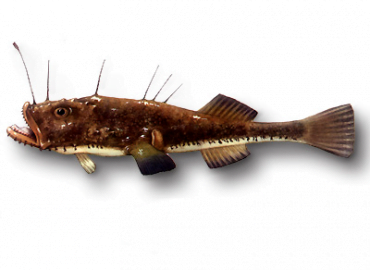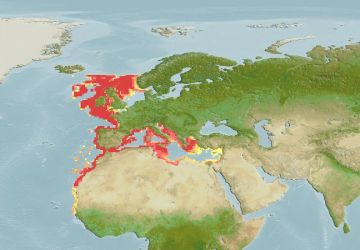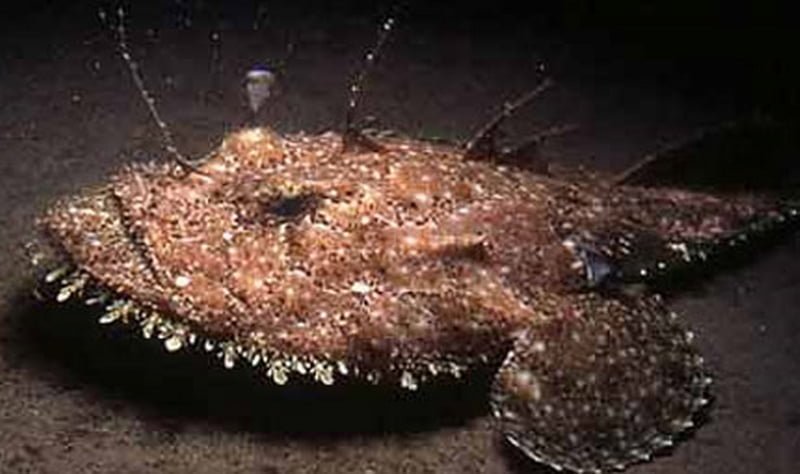Lophius Budegassa
– Blackbellied Angler –

| Scientific classification |
|---|
Lophius budegassa Spinola, 1807
| Kingdom: | Animalia |
| Phylum: | Chordata |
| Class: | Actinopterygii |
| Order: | Lophiiformes |
| Family: | Lophiidae |
| Genus: | Lophius |
| Species: | L. budegassa |


Lophius budegassa, the blackbellied angler, is a species of anglerfish in the family Lophiidae. It was described by Maximilian Spinola in 1807. The fish is found in a depth range of 300–1,013 metres (984–3,323 ft) in the eastern Ionian Sea while in the inshore waters of the United Kingdom it is found at a depth of 650 metres (2,130 ft). It is also found off the coast of Senegal and in Mediterranean Sea. The species can extend up to 100 centimetres (39 in) but is commonly half of that size.[1] In regard to the length frequency distribution, the Mediterranean International Trawl Survey’s (MEDITS) data sets of 1994-1999 show a clear predominance of the species smaller than 30 cm in the central and eastern Mediterranean (Ionian, Adriatic, and Aegean seas).[2] It has also been found that the spawning period of this species occurs over several months; furthermore, the growth rate of juveniles has been shown to be faster than previously expected.[3]
Biotope
Angler fish par excellence, the monkfish live more generally on soft bottoms between 2 and 1000 meters, or even deeper (catches have been reported at 1800 meters).
However, it can also be found in eelgrass beds and on rocky bottoms, very close to the shore.
Description
With its enormous head (it constitutes 60% of the animal’s weight), its widely slit mouth and its highly developed pectoral fins , the monkfish cannot be confused with any other fish.
The body is round in section at the tail, flattened towards the head.
The first three rays of the dorsal fin are placed very forward; the first, located in front of the eyes, has a flap of bifid skin that the animal uses as bait.
The skin is smooth , devoid of scales and slightly viscous.
A row of branched appendages, more developed around the head, borders the middle part of the body.
The branchial openings in the top position are protected by two osseous opercula * inserted under the skin.
The teeth are strong, pointed and curved backwards.
The size, in adults, is between 70 and 200 cm. The weight of large individuals is around 40 kg, for a recorded maximum of 58 kg.
The general color is a light brown mottled with darker areas, which may vary depending on the environment. Despite their large size, anglerfish are quite good at camouflage.
Similar Species
Lophius budegassa can be confused with Lophius piscatorius , the white anglerfish , also called frogfish.
This second species, bigger (average size 80/90 cm) lives, in principle, further north, from the British Isles to Senegal where it coexists with L. vaillanti and in the Mediterranean / Black Sea area.
Few obvious morphological differences apart from the average size: pectoral fins less developed, the bait of the first ray of the dorsal is simple (bifid in L. piscatorius ).
The main difference is … the color of the peritoneum, white in L. piscatorius , black in L. budegassa .
Monkfish, widespread all over the world, include around forty species divided into three genera: Lophius , Lophioides and Lophiomus . Among the most common: Lophius vaillanti , African Anglerfish , Lophius vomerinus , Cape Anglerfish , Lophius americanus , American Anglerfish , Lophius litulon , Japanese Anglerfish , Lophius gastrophysus , Anglerfish.
Alimentation
The Anglerfish is a predator hunting on the lookout. Flattened on the bottom, sometimes lightly silted up or camouflaged among the algae, it uses the first ray of its dorsal fin like a fishing rod carrying an appetizing bait …
The huge mouth becomes invisible when closed. The appendages which border it, arranged in a row, make its outlines indistinguishable. As a fish approaches and the opening goes off, causing a suction that is hard to resist. Everything goes there: fish, crustaceans and even sea birds.
The Anglerfish, capable of hunting in very little water, does not hesitate to swim to capture seagulls or gulls on the surface.
An anglerfish, caught in Concarneau in 1976 contained … a nutria!
Reproduction
The laying period is at the end of winter, the eggs, agglomerated, form ribbons several meters in length often containing several million eggs.
The hatching of the larvae * takes place at the end of May, beginning of June; they then measure 10/12 mm and lead a planktonic life *.
At 5/6 cm, they join the bottom.
Sexual maturity is reached around 6/7 years for a size of about 70 cm.
Various Biology
It is quite often observed that the large anglerfish encountered in shallow water have lost their lure … from there to think that they take the risk of hunting near the shore, a potentially dangerous area, to increase their chances of capture, it there is only one step …
Further Information
Monkfish are fish of great economic importance. Usually fished by trawl, they are also caught by means of gillnets, in the Celtic Sea and on the edges of the continental slope in the Bay of Biscay. The authorized catch tonnages for Europe (TAC) are 31,918 tonnes per year, with French fisheries representing a little more than half of the tonnage caught. At this level, the distinction between the two species is not taken into account. The resource in slight regression, does not seem very threatened … if the fishing pressure does not increase. The major problem for a good management of this fishery results in particular from the lack of selectivity of the catching methods used. Juvenile anglerfish living in the same areas as adults, large numbers of




































































































































































































































































































































































